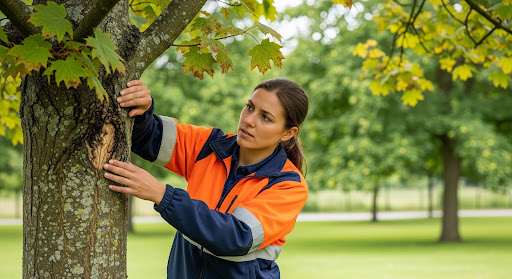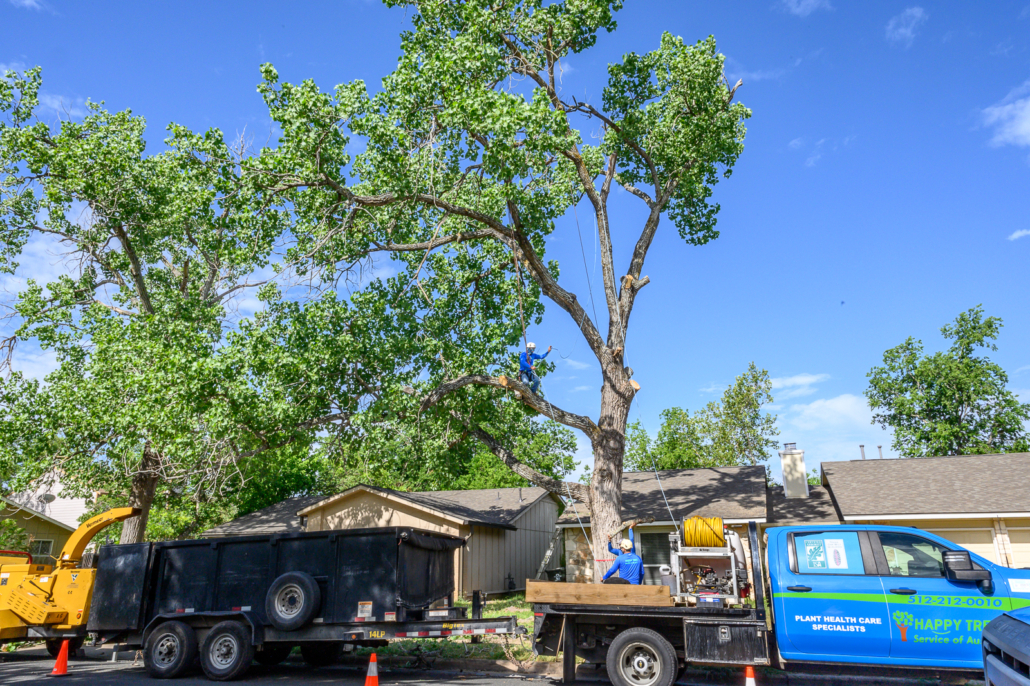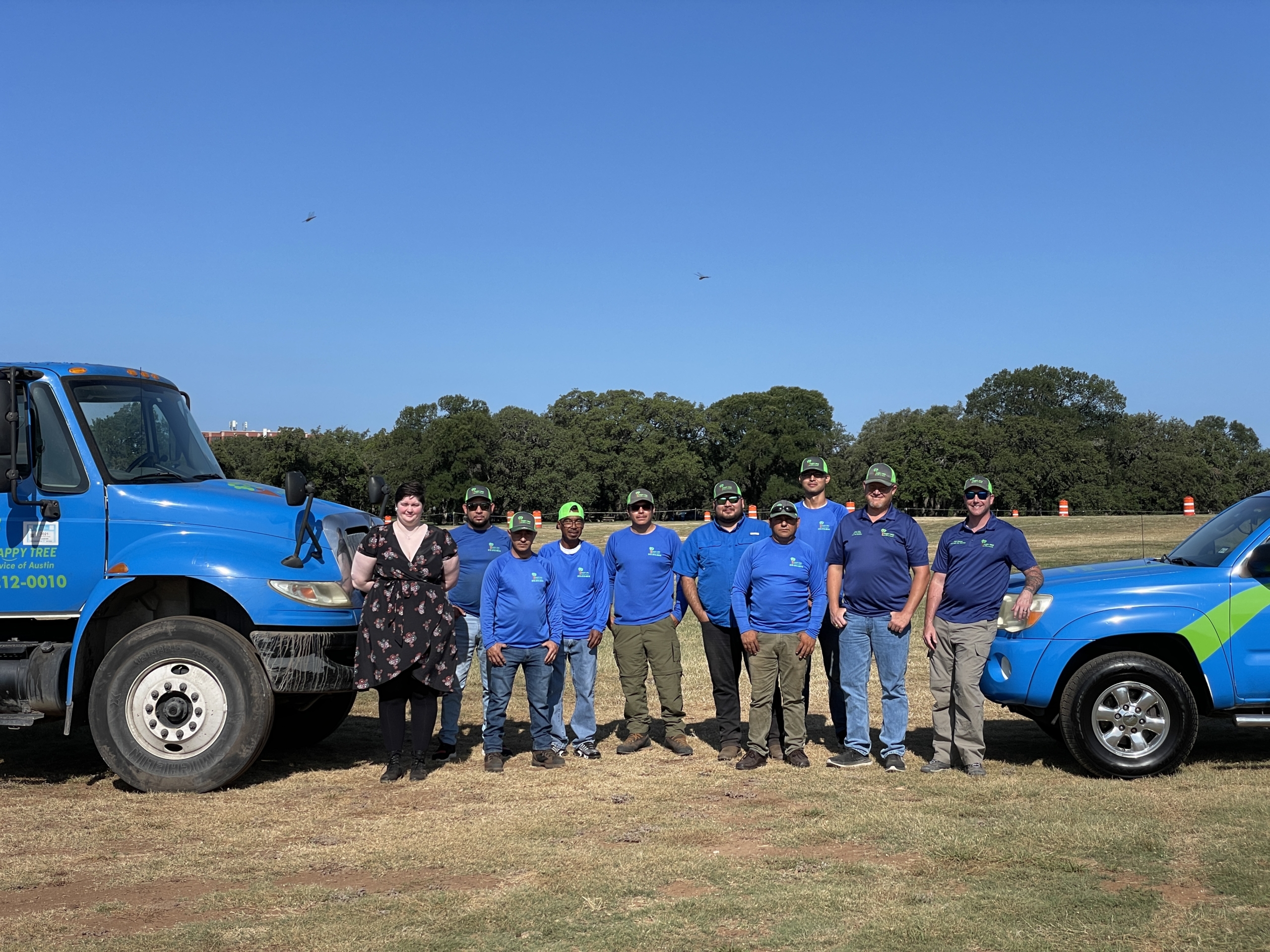Tree Health Care in Austin, TX – Certified Arborist Tree Inspections, Treatment & Nutrient Care Services
![]() 230+ Google Reviews
230+ Google Reviews
Schedule an Appointment Today & Find Out Why Our Customers Consistently Rate Our Austin Tree Company 5 Stars: 512-212-0010
![]() 230+ Google Reviews
230+ Google Reviews
Schedule an Appointment Today & Find Out Why Our Customers Consistently Rate Our Austin Tree Company 5 Stars: 512-212-0010
Keeping trees healthy in Central Texas requires more than occasional trimming or watering. Heat, drought, soil challenges, and pests create constant stress. Without a plan, even mature, established trees can decline faster than expected. The best way to preserve your property and protect Austin’s urban canopy is with preventive, science-driven care.
At Happy Tree Expert Tree Services & Arborist in Austin, we approach tree health the way we would any living system: with knowledge, testing, and long-term planning. Our ISA Certified Arborists combine advanced training, laboratory diagnostics, and more than 30 years of local experience to give you clear answers and reliable solutions. By staying proactive, you reduce risks, avoid costly removals, and help your trees stay strong and safe year-round.

We believe tree care should be built on evidence, not guesswork. Our method combines certified expertise, research-backed processes, and a customer-first philosophy. Each element works together to give you confidence that your trees are receiving the right care at the right time.
When you work with us, your trees are evaluated by ISA Certified Arborists. This certification represents the highest professional standard in arboriculture and ensures our team understands tree biology, safe tree prunning Austin techniques, and long-term preservation strategies. In addition, our team carries specialized qualifications, including Tree Risk Assessment and Texas Oak Wilt credentials. These certifications give us the ability to recognize threats early and apply proven treatments that protect your investment.
Effective tree health care starts with accurate diagnosis. Instead of making assumptions, we evaluate soil compaction, structure, moisture levels, pH balance, and nutrient availability. We also collect root, twig, and leaf samples and send them to the Texas A&M Plant Pathology Lab when further testing is required. This partnership gives us detailed data to confirm or rule out diseases. By basing treatment on evidence, we deliver better outcomes for both you and your trees.
For more than 30 years, we’ve cared for trees across Austin and Central Texas. This experience has given us firsthand insight into the unique challenges of our climate. From prolonged droughts to severe storms and invasive pathogens, we’ve seen what works and what doesn’t. That history allows us to provide time-tested recommendations tailored to your property.
Healthy trees create long-term value for your home or business, and our goal is to build the same kind of lasting relationship with our clients. We take time to explain findings in plain language, outline treatment options, and follow through on every promise. By focusing on integrity and trust, we make sure you always know what to expect and feel confident in the care we provide.
Trees in Austin face pressures that go beyond normal wear and tear. Harsh summers, dense clay soils, and disease threats all contribute to decline. By understanding the most common issues, you can recognize early warning signs and call for help before problems become emergencies.
Oak wilt is one of the most destructive diseases in Texas, threatening the iconic live oak as well as red oaks and Mexican white oaks. The fungus that causes oak wilt spreads underground through root connections and above ground via insect activity. Early symptoms include browning along the veins of leaves, premature leaf drop, and rapid canopy loss. Once advanced, oak wilt can kill a tree in a matter of months.
Prevention and early action are critical. Our Texas Oak Wilt Qualified arborists diagnose and treat the disease using fungicide injections applied during the safe seasonal window. We also provide specialized oak wilt treatment services to protect Austin’s most valuable oaks. We also help homeowners follow preventive measures, including pruning oaks only between July and January.
Urban landscapes often leave little room for roots to breathe. Heavy clay soils, foot traffic, and construction can compress soil so tightly that air and water cannot penetrate. Without oxygen and nutrients, trees become stressed and vulnerable to decline.
Construction activity, storms, and general stress can damage root systems, creating entry points for fungi and bacteria. Once infections take hold, decay spreads through the root zone and into the trunk. If left untreated, the tree may weaken to the point where removal is the only safe option.
Healthy trees naturally defend themselves against most insects, but stressed trees are easy targets. Bark-boring beetles, caterpillars that strip leaves, and other pests can overwhelm weakened trees. When infestations occur, our approach is two-fold: remove the destructive insects and then strengthen the tree so it can resist future attacks.

Tree health care should be comprehensive, covering everything from prevention and diagnosis to treatment and support. At Happy Tree Service of Austin, we offer a full suite of services designed to protect trees at every stage of life. Together, they form a holistic plan for healthier landscapes, stronger roots, and safer properties.
Healthy soil is the foundation of healthy trees. Unfortunately, Austin soils are often compacted and lack balance. Even everyday activities like walking across a lawn can compress soil particles, leaving no room for air or water. When this happens, roots suffocate and trees decline.
We begin with a soil test to measure compaction, pH, and nutrient content. With this information, we can create a customized plan. For some trees, that may mean adjusting pH levels to make nutrients more available. For others, it may involve aerating the soil or applying organic amendments. Once the analysis is complete, we create a fertilization mix tailored to your soil and your tree’s needs.
Not all fertilizers are the same. Many commercial products release nutrients too quickly or are designed for turf rather than trees. We use only high-quality, slow-release fertilizers created specifically for arboriculture. These products provide steady nutrition, avoid root burn, and deliver consistent support for long-term health.
Trees cannot tell us when something is wrong, which makes accurate diagnosis especially important. Many diseases produce similar symptoms—yellow leaves, thinning canopies, or premature leaf drop. Misdiagnosis wastes time and allows disease to spread.
Our arborists rely on a combination of observation and lab testing. We look for visible signs in leaves, bark, and roots, and when needed, collect tissue or soil samples for analysis at the Texas A&M Plant Pathology Lab. With scientific confirmation, we design treatment plans that target the exact disease. This ensures resources are used effectively and nearby trees are protected.
Different tree species have different nutritional requirements, and Central Texas soils often make it difficult for trees to access what they need. High pH levels, in particular, lock nutrients in the soil so they remain unavailable to roots.
We provide deep root fertilization Austin homeowners rely on, injecting slow-release, liquid fertilizers directly into the root zone. These custom blends give trees access to the macro- and micronutrients they need for healthy growth. With proper nutrition, trees develop stronger canopies, greener foliage, and greater resilience against pests and disease. This service is especially valuable for urban trees, where natural nutrient cycling is limited by landscaping practices.
A tree’s root collar—the area where the trunk flares into major roots—should always be visible at ground level. In many Austin landscapes, this critical area gets buried under added soil or mulch. Builders may change grades during construction, or homeowners may add decorative borders and fill with soil for planting. Sometimes mulch is piled too high around the trunk, a practice known as “volcano mulching.”
Covering the root collar creates long-term problems. Roots may begin growing upward into the added material, eventually circling the trunk in a process called girdling. Girdling roots can choke the tree over time. Constant contact between trunk tissue and moist soil also leads to decay and opens the tree to fungal infections.
To correct this issue, arborists use air spading services with a specialized tool called an air spade. The air spade directs compressed air into the soil, blowing it away without cutting or damaging roots and trunk tissue. This allows us to safely expose the buried root collar, restore natural airflow, and reduce the risk of disease. The longer a tree remains buried, the harder it is to correct, which is why early intervention matters.
Compacted soil is one of the leading causes of tree decline in urban environments. Heavy clay soils, foot traffic, and construction all press soil particles tightly together, leaving little space for water and air to reach the roots. Without oxygen and moisture, roots cannot function properly, and trees begin to weaken.
Aeration is one of the most effective ways to address this problem. Using an air spade or an auger, we create a grid of holes six to eight inches deep throughout the tree’s critical root zone, extending out past the drip line. These holes are backfilled with organic compost, which restores pathways for air and water while adding nutrients.
Root zone invigoration builds on this process. Along with compost, we add biochar (a form of carbon-rich charcoal) and a blend of beneficial mycorrhizal fungi. Mycorrhizae form natural partnerships with tree roots, expanding the root system’s ability to absorb water and nutrients. This symbiotic network increases drought tolerance, improves soil structure, and supports long-term soil health.
By combining aeration with soil enrichment, we transform compacted ground into a healthier environment that supports stronger, more resilient trees.
Pruning is one of the most powerful tools for maintaining tree health, but it must be done with care. Over-pruning is a widespread problem in Austin. One common mistake, known as lion-tailing, strips away interior branches and leaves foliage only at the ends of long limbs. This weakens trees, increases the risk of limb failure, and limits the tree’s ability to produce food through photosynthesis.
Our pruning philosophy is simple: less is more, and every cut should serve a purpose. Our ISA experts also provide professional tree trimming services for residential and commercial properties. The best pruning focuses on removing deadwood, eliminating structurally unsound limbs, and reducing overextended or heavy branches. Proper pruning strengthens the tree’s structure, balances weight, and allows more light and airflow through the canopy.
Timing is also critical. Peaches and other fruit trees benefit from winter pruning, which directs energy into spring fruiting. Oaks should only be pruned from July through January to minimize the risk of oak wilt infection. For most deciduous trees, pruning is best performed just before or after leaf drop. Regardless of the species, all tools must be sterilized between cuts to prevent the spread of pathogens.
When a tree is too diseased or damaged to recover, professional tree removal services become necessary. Our arborists plan each removal carefully, accounting for site conditions, surrounding structures, and tree size. We use proper rigging, cranes when required, and controlled cutting methods to prevent property damage. Once the tree is removed, our crews perform thorough cleanup, leaving your property safe and ready for the next stage of landscaping.
We believe tree planting Austin residents can count on is an investment in the future. A properly planted tree provides decades of shade, beauty, and environmental benefits. Our arborists guide you through species selection, ensuring the right tree is chosen for your soil type, available space, and landscape goals. Native and adaptive species are always prioritized for their resilience in Central Texas conditions.
Timing is as important as placement. Planting during the extreme heat of summer puts stress on young trees. Instead, we recommend planting in fall or early winter, when cooler temperatures and seasonal rains give roots a chance to establish before the return of summer stress. Planting the right tree in the right place—and at the right time—sets your landscape up for long-term success.
Some trees develop weak branch unions, multiple leaders, or structural imbalances that put them at risk of failure. Our tree cabling and bracing services use reinforcement techniques that provide added stability.
Cables are installed high in the canopy to reduce movement and redistribute weight. Braces and bolts may be used within the trunk or major limbs to strengthen weak points. These systems do not eliminate risk but can extend the life of valuable trees, reduce hazards during storms, and prevent unnecessary removals.
Oak wilt remains one of the most serious threats to Austin’s tree canopy. The fungus spreads through interconnected roots and by insects carrying spores from infected trees. Once symptoms appear—such as leaf vein browning, rapid canopy loss, and premature defoliation—trees decline quickly.
Our team includes Texas Oak Wilt Qualified arborists trained in accurate diagnosis and treatment. When appropriate, we apply fungicide injections directly into the vascular system of the tree to halt the spread. We also educate property owners on preventive practices, such as pruning during safe seasonal windows and avoiding fresh wounds that attract insect vectors. By combining treatment with prevention, we help protect both individual trees and the larger oak community.
Severe storms can leave trees damaged, leaning, or fallen. These situations create immediate hazards for homes, vehicles, and people. Our emergency crews are available 24/7 to respond quickly. We arrive with the equipment and expertise needed to stabilize dangerous trees, remove broken limbs, and restore safety. By acting swiftly, we help minimize property damage and prevent further risk.
Businesses, HOAs, and apartment communities depend on consistent, reliable tree care to keep properties safe and welcoming. Large landscapes require a scalable approach, with services ranging from routine trimming and soil management to emergency response.
Happy Tree Service of Austin partners with businesses to deliver tailored commercial tree services Austin property managers trust. We provide risk assessments, pruning schedules, fertilization plans, and removals that fit both the property’s needs and its budget. By combining certified arborist oversight with efficient crews, we ensure that even the largest projects receive the same level of detail and science-backed care as a single residential tree.
Trees often look sturdy from a distance, but small warning signs can appear long before serious problems develop. Catching these issues early allows you to prevent costly interventions and avoid property risks. Our team helps you understand the red flags so you’ll know when to call for professional tree care.
Discolored leaves are one of the most common indicators of stress. Nutrient deficiencies, compacted soil, or root damage can all cause leaves to lose their rich green color. In Central Texas, oak wilt is another major concern, often showing first as browning along the leaf veins. If you see leaves changing color outside of normal seasonal cycles, it may be time for a professional evaluation.
Healthy trees shed leaves at predictable times of year. When leaves drop too early, it usually signals stress from disease, pests, or water shortages. Premature leaf loss weakens the tree’s ability to produce energy and makes it more vulnerable to storm damage and secondary infections.
Mushrooms or fungal shelves (also called conks) around the base of a tree often point to internal decay. These fungal infections can spread quickly and compromise structural stability. Because trees with advanced decay are more likely to fail in storms, a certified arborist should evaluate them right away.

Austin’s climate shifts from scorching summers to sudden freezes, with storms in between. Each season creates different needs for your trees. Our tailored seasonal tree care services Austin help maximize growth and prevent damage year-round.
From November through April, the focus is on preventive care. Cooler temperatures create the best conditions for planting, giving roots time to establish before summer stress returns. This is also the ideal season for deep root fertilization, strengthening trees for the coming year. Fall and winter provide the best opportunity for oak wilt fungicide injections as well. Because these treatments rely on active water movement inside the tree, cooler months improve their effectiveness.
Spring and summer bring rapid growth but also greater stress. Structural pruning becomes especially important, as it reduces the risk of limb failure during storms. Regular monitoring for pests and fungal infections is also critical, since these problems spread faster in warm weather. Fertilization during this time supports canopy development and helps trees recover from early-season stress.
We proudly serve Austin and surrounding communities with complete tree health care for both residential and commercial properties. Our service areas include:
This coverage ensures our certified arborists are available to help whether you manage a downtown property, a hill country estate, or a commercial landscape.
Tree health care is about more than appearances—it’s about protection, savings, and peace of mind. Preventive care helps you avoid:
Proactive healthcare extends the life of your trees and reduces risks to your home or business. Most importantly, it removes uncertainty. You don’t have to worry each time a storm approaches about whether a weak tree might fall. With the right plan, you can feel confident that your landscape is safe, healthy, and prepared for Central Texas weather.
At Happy Tree Service of Austin, we believe proactive care is the most effective way to protect both your property and the trees that make it beautiful. From soil testing and oak wilt prevention to pruning and emergency response, our certified arborist Austin TX team provides science-backed care tailored to Central Texas conditions.
If you’ve noticed stress in your trees or want to take a preventive approach, now is the time to act. Call us at 512-599-9948 or reach out online to schedule a free estimate. Let our team help you safeguard the beauty, safety, and value of your landscape year-round.
Evan Peter, Certified Arborist – TX-4602A
Lewis Heye, Certified Arborist – TX-3510A

